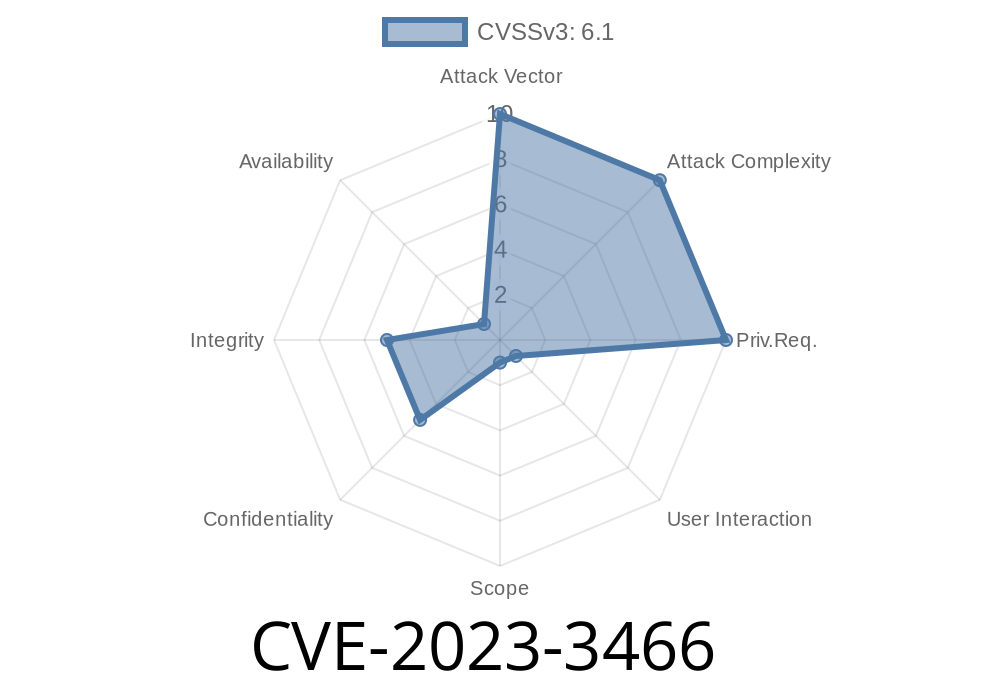Security researchers have recently discovered a new security vulnerability, CVE-2023-3466, which is categorized as a Reflected Cross-Site Scripting (XSS) vulnerability. This vulnerability can be exploited by malicious attackers to compromise the security of vulnerable web applications, steal sensitive user data, or perform other harmful actions. In this long read post, we will reveal the details of this vulnerability, explain how it can be exploited, and provide code snippets and links to the original references.
Reflected XSS Vulnerability Explained
A Reflected Cross-Site Scripting (XSS) vulnerability occurs when an attacker can inject malicious scripts into web applications that suffer from insufficient input validation. This usually happens when an application accepts user input and includes it in the pages it generates without properly sanitizing or encoding it. Consequently, an attacker can supply crafted input that includes malicious scripts, which are executed in the context of the victim's browser when they visit the affected web page.
Original Reference Links
The following are the primary links to resources where you can find more information and details about CVE-2023-3466 vulnerability:
1. Official CVE Details: https://cve.mitre.org/cgi-bin/cvename.cgi?name=CVE-2023-3466
2. National Vulnerability Database (NVD) Details: https://nvd.nist.gov/vuln/detail/CVE-2023-3466
Here's a simple example of a vulnerable PHP code that suffers from a Reflected XSS vulnerability
<?php
// Example of vulnerable PHP code
$search = $_GET['search'];
?>
<!DOCTYPE html>
<html>
<head>
<title>Search Results</title>
</head>
<body>
<h1>Search Results for: <?php echo $search; ?></h1>
<!-- rest of the page content -->
</body>
</html>
In this example, the $search variable directly includes the user input obtained through the GET parameter 'search' without any validation or sanitization. This allows an attacker to craft a malicious URL containing a script, which executes when the victim visits the URL.
Exploit Details
To exploit this Reflected XSS vulnerability, an attacker can craft a URL containing a malicious script. Here's an example of an exploit URL:
https://example.com/search.php?search=<script>alert(document.cookie);</script>;
When a victim clicks on this URL or visits the page, they trigger the malicious JavaScript code embedded within the search parameter. This code displays an alert containing the victim's session cookies, which an attacker can use to hijack the victim's session.
There are a few effective methods to protect web applications from Reflected XSS vulnerabilities
1. Input Validation and Sanitization: Validate and sanitize user input to ensure that it does not contain harmful content before including it in a web page. PHP functions like htmlspecialchars() and strip_tags() can be used to safely encode user input.
2. Content Security Policy (CSP): Implement a CSP to restrict the execution of scripts from untrusted sources. This provides an additional layer of security and reduces the risk of XSS attacks.
3. HTTP Security Headers: Use HTTP response headers like 'X-Content-Type-Options' and 'X-XSS-Protection' to improve the overall security of your web application and help protect against various browser-based vulnerabilities.
Conclusion
CVE-2023-3466 is a security vulnerability that affects web applications suffering from Reflected Cross-Site Scripting (XSS) issues. By understanding its nature and the methods to exploit it, developers and security professionals can better protect their web applications and users. Implementing proper input validation, enforcing a Content Security Policy, and using HTTP security headers are some of the effective ways to mitigate this kind of vulnerability. Stay informed on the latest vulnerabilities and patches to keep your applications and users safe!
Timeline
Published on: 07/19/2023 19:15:00 UTC
Last modified on: 07/28/2023 14:54:00 UTC
